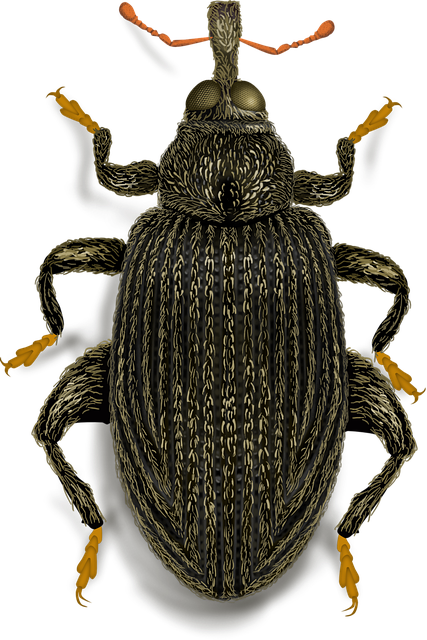Understanding stinging insects like bees, wasps, and hornets is crucial for effective child- and pet-safe pest control. Professional exterminators employ tailored treatments, nest removal, and exclusion strategies to eliminate colonies and prevent reinfestation. Alternative methods include using natural repellents like citronella, lavender, and catnip, as well as planting herbal barriers and installing fine mesh screens. Regular maintenance of physical barriers and deep cleaning the home are also key to successful stinging insect extermination, ensuring a safer environment for children and pets without relying on chemical pesticides.
Tired of pesky stinging insects invading your space? Discover safe and effective methods for stinging pest control, ideal for families with children and pet owners. This comprehensive guide explores natural repellents, behavior understanding, and preventative measures. Learn how to create an insect-free environment using child- and pet-safe techniques, eliminating the need for harsh chemicals. Say goodbye to stings and hello to a peaceful, bug-free haven with our expert advice on stinging insect extermination.
Understanding Stinging Insects and Their Behaviors
Understanding stinging insects and their behaviors is crucial for implementing effective child- and pet-safe pest control methods. These insects, such as bees, wasps, and hornets, play a vital role in our ecosystem but can pose significant risks when they establish nests near homes or in areas frequently accessed by children and pets. To address this, it’s essential to know their habits and patterns. For instance, some species are more aggressive when protecting their nests, while others may sting only if provoked or threatened.
Stinging insect extermination requires a thoughtful approach that considers both safety and efficiency. Professional exterminators use specialized equipment and treatments tailored to minimize the risk of stings while eliminating colonies effectively. They also employ strategies like nest removal and exclusion techniques to prevent reinfestation, ensuring a safe living environment for both families and their furry friends.
Pet- and Child-Friendly Alternatives for Pest Control
When it comes to dealing with stinging insects, many traditional methods rely on chemicals that can be harmful to both pets and children. Fortunately, there are pet- and child-friendly alternatives for pest control that offer effective protection without the risk. These methods focus on natural repellents and non-toxic solutions, ensuring a safer environment for everyone in the household.
One such alternative is using essential oils, like citronella, lavender, and peppermint, which have been proven to deter stinging insects. Planting herbal repellents around your home or using natural sprays made from these ingredients can significantly reduce insect bites. Additionally, physical barriers such as fine mesh screens on windows and doors, along with sealed gaps and cracks, can prevent stinging insects from entering your living spaces. These simple yet effective methods offer a peaceful and secure solution to stinging insect extermination, keeping both pets and children safe.
Natural Repellents and Safe Application Techniques
When it comes to stinging pest control, opting for natural repellents is an eco-friendly and child-safe alternative to chemical pesticides. Plants like citronella, lavender, and catnip are known to deter insects due to their strong scents. Essential oils from these plants can be diluted and applied to the skin or used in diffusers to create a protective barrier against stinging insects.
For safe application, always follow instructions on product labels and conduct patch tests before widespread use. For skin applications, mix a few drops of essential oil with a carrier oil like coconut or jojoba. When using diffusers, ensure proper ventilation to avoid inhalation issues. Regularly changing the water and replacing pads in diffusers also helps maintain their effectiveness. These natural methods offer effective stinging insect extermination without compromising safety for children and pets.
Preventative Measures: Creating an Insect-Free Environment
Creating a pest-free environment is half the battle won in the war against stinging insects. To prevent these pesky creatures from setting up camp, start by sealing any gaps or cracks in your home’s exterior. Insects often find their way inside through open windows, doors, and vents, so ensure these are fitted with fine mesh screens to keep them out. Regularly inspect and maintain your screens, fixing any tears or holes that could provide an entry point.
Inside your home, take steps to minimize areas where insects can breed. Empty and clean bird feeders and flower pots regularly, as these can attract bugs. Don’t leave standing water anywhere, as it’s a breeding ground for mosquitoes. Keep your kitchen and dining areas spotless, cleaning up any spills or crumbs immediately, as food residue attracts ants and other pests. Regular deep cleaning and maintaining a clutter-free space will make your home less inviting to stinging insects, making extermination efforts more effective.
In conclusion, effectively managing stinging insects requires a shift towards safer, pet- and child-friendly methods. By understanding these pests’ behaviors, exploring natural repellents, adopting preventative measures, and utilizing modern techniques like essential oils and strategic landscaping, you can achieve a balanced approach to stinging insect extermination while ensuring a secure environment for all.
